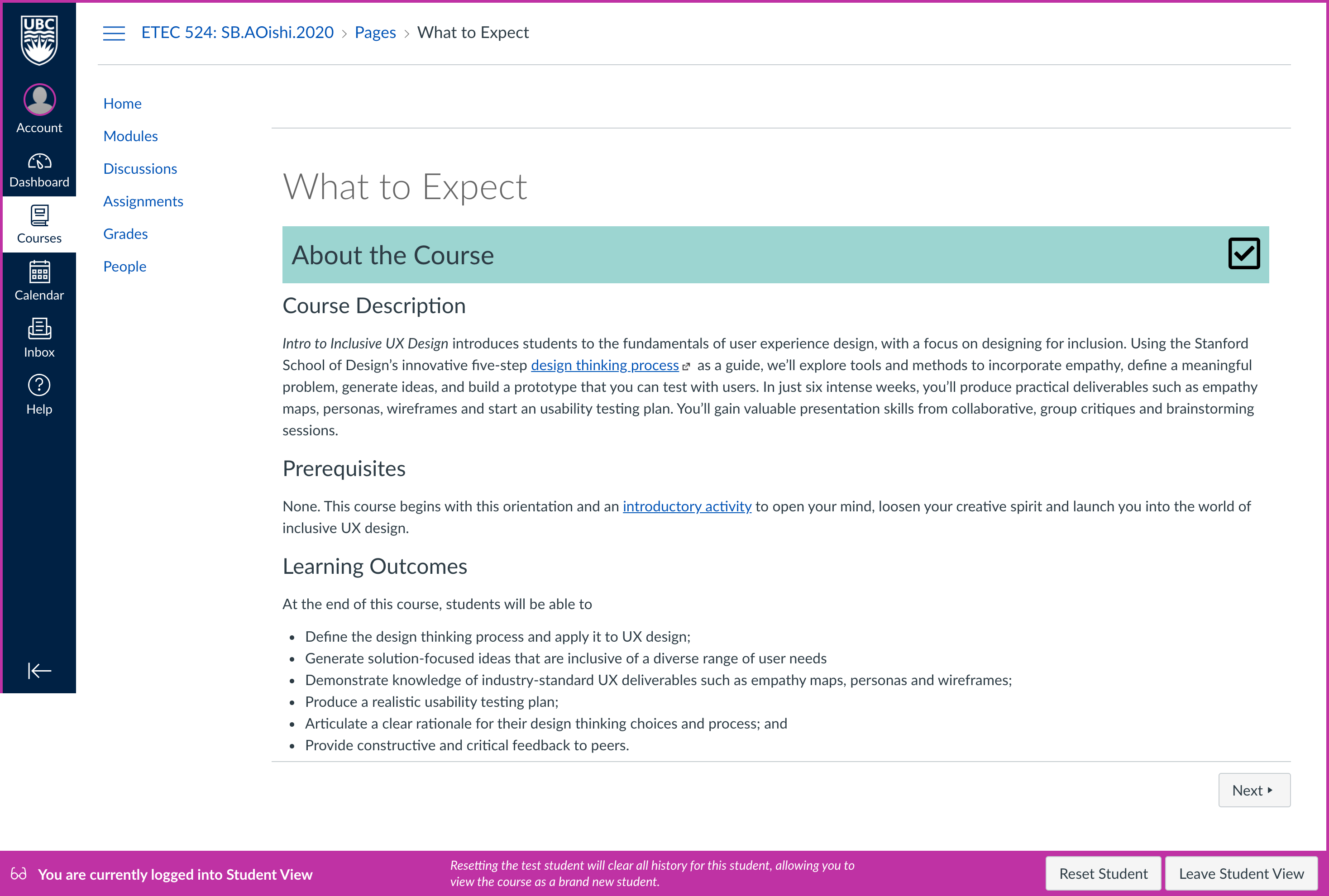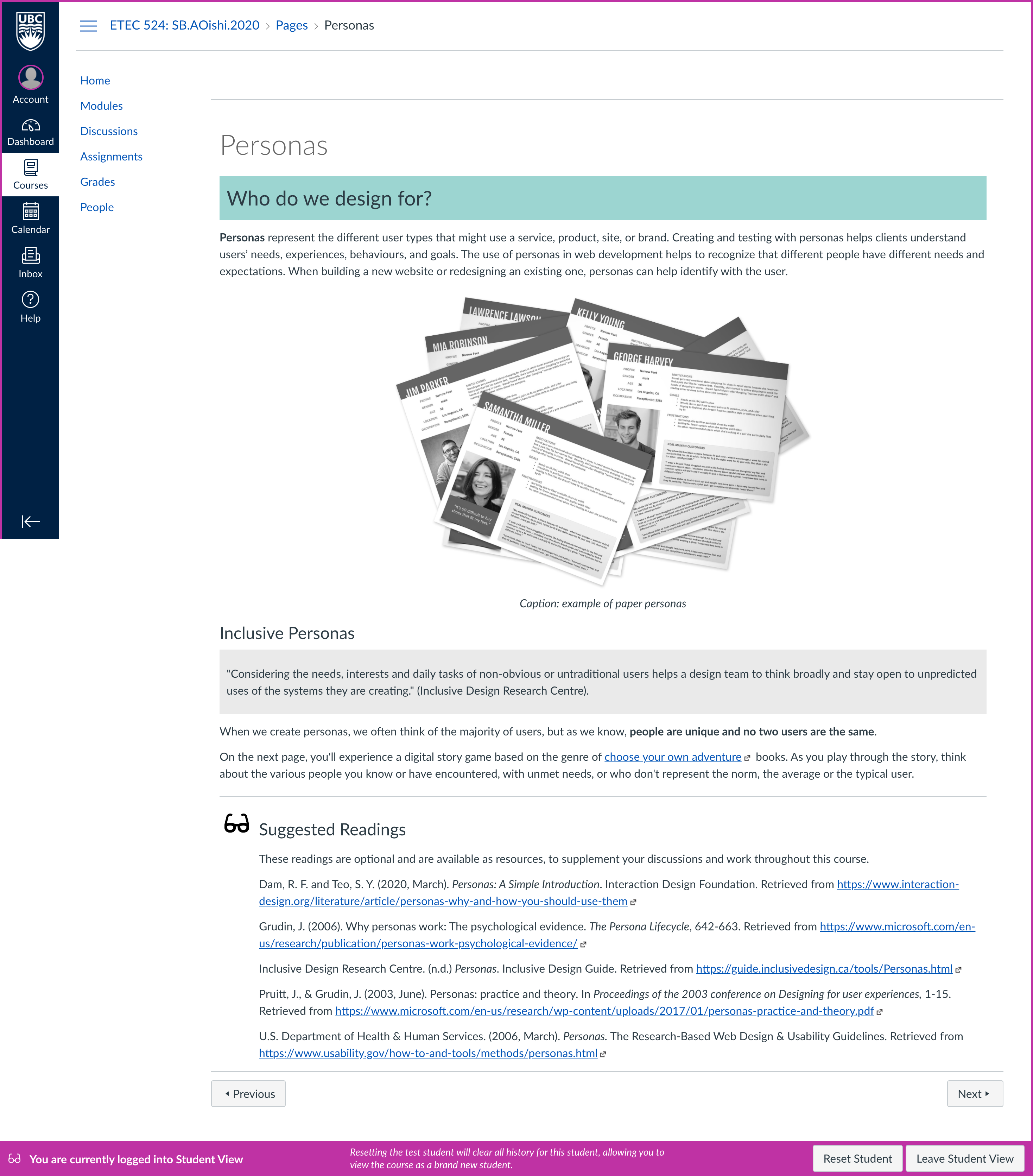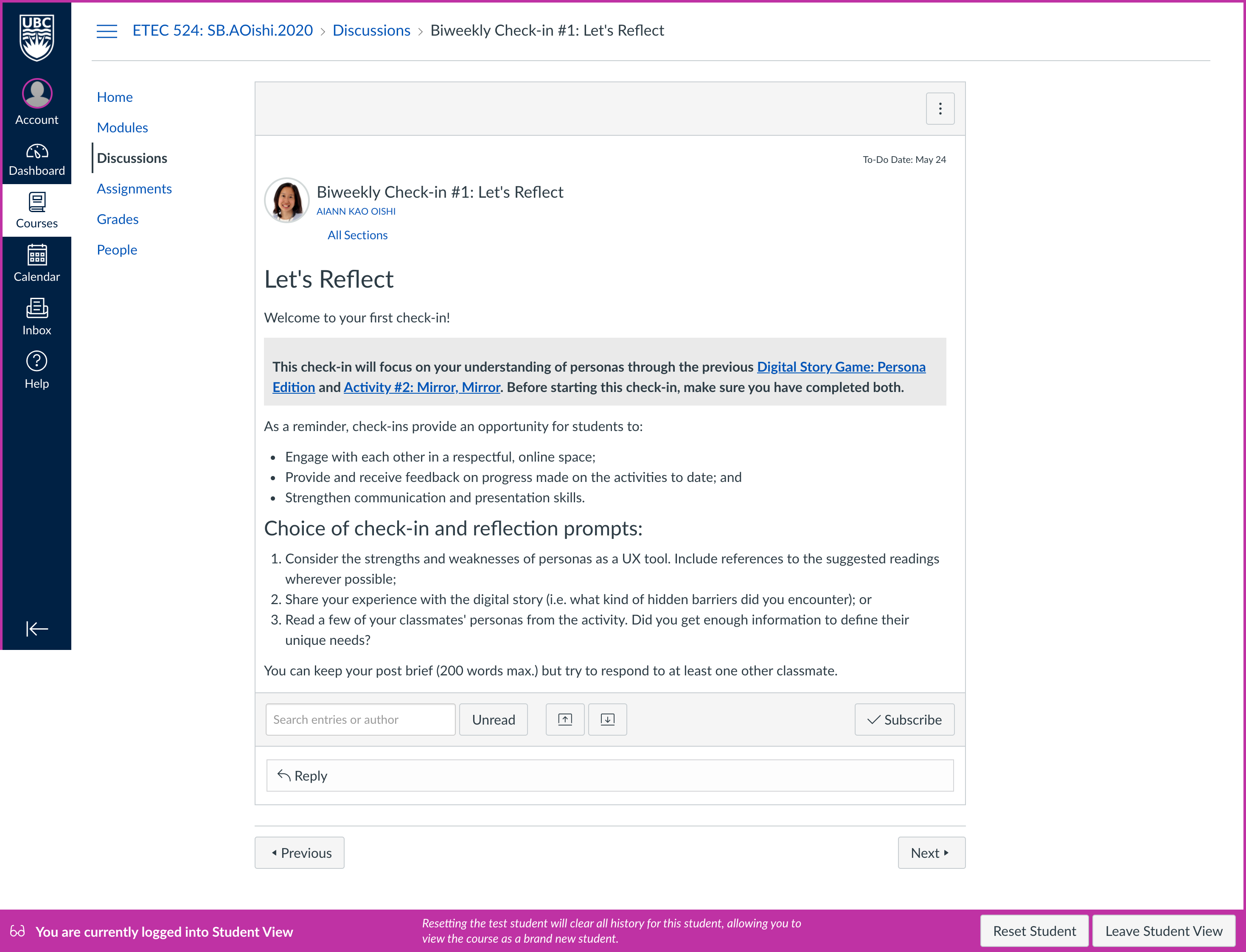Objective and Approach
Intro to Inclusive UX Design was created to fill the growing need for user experience (UX) design education, that focuses on designing accessible digital products for a wide range of human diversity. While the course is aimed at website designers and developers, the UX process can be applied to professionals in other contexts. Click on the image to view larger.


Designing a flexible learning environment for the 21st century student, means using practices that encourage the development of self-directed, collaborative and critical thinking skills (Benade, 2017). Practices include taking advantage of assessment strategies “that are project and workplace-based” (Anderson, 2008b, p. 50) and by adopting a less dominant role to facilitate “greater learner commitment and participation” (p. 59). As the course instructor and designer, I accomplished this in a number of ways:
Student-Teacher Interaction: Introductory Activity
Design thinking, especially in the empathy phase involves letting go of assumptions, biases and personal beliefs to understand an user’s unique needs (Stanford University, 2018). In UX design, asking How Might We (HMW) questions encourages designers to adopt an open, beginner’s mindset. HMW involves a design challenge (i.e. the problem) and a point-of-view statement (from a sample user) to generate a series of questions that may lead to solutions in later phases.
While typically done face-to-face, HMW was adapted as an online introductory activity using the discussion forums, to be an “icebreaker” to design thinking. Although running as an asynchronous course, students starting orientation will likely be new and not know each other’s communication styles. I chose to rely on a student-teacher interaction to reduce discomfort and initially lead the discussion. My intent would be that students start to become more comfortable with reflective, design thinking and communicating with each other from this introductory activity.
Student-Student Interaction: Biweekly Check-ins
Design critiques are a core part of UX design; they foster trust, cooperation and collaboration among team members and keep stakeholders up-to-date on progress (Gibbons, 2016). The biweekly check-ins scheduled throughout the course, provide opportunities for students to engage with each other, provide and receive critical feedback and develop interpersonal skills that are valuable in the workplace.
Assessments: Project- and Workplace-Based
Formative
Throughout the course, students are formatively assessed, producing tangible deliverables associated with stages of the UX design process. Deliverables such as empathy maps, personas and wireframes are all common client deliverables that an UX designer produces (Komninos, 2020). Using Padlet, an online collaborative whiteboard, students have the opportunity to participate in a group brainstorming discussion. While not graded, the student participation will be assessed by level of engagement and diversity of ideas generated.
Summative
The final assignment was designed to be a summative assessment; students produce a draft plan for testing the usability of their deliverables that were created throughout the course. From the beginning, students have had opportunities to gain transferable skills such as presenting information, organizing content and writing a clear rationale. These skills will be assessed when reviewing the plan’s presentation and quality of work. The goal is that students will leave the course with learning outcomes (i.e. communication and interpersonal skills, idea generation) that they can transfer to other contexts.
Safe Spaces: Orientation
Anderson (2008a) describes the need to develop a “develop a sense of trust and safety within the electronic community” (p. 350), as a critical first step when facilitating discourse. The course makes use of online discussion forums so it was important to create a safe space early on.
Borrowing from game-based learning principles that have proved successful, I recreated the course syllabus as an orientation module in Canvas. In video games, “fish tanks” are scaled-down versions of the game, often playable as tutorials at the beginning (Gee, 2005).
When adapted for learning, they allow players to master a few key elements and encourage a positive start to the full system (p. 8). The orientation is designed to be light-hearted, with titles referencing travel (i.e. “Pack your bags” instead of course materials or “Itinerary” for course schedule) and require minimal effort to complete. While the syllabus is available as an electronic PDF file, orientation allows students to have a sense of accomplishment and gain confidence before even starting the course modules.
References
Anderson, T. (2008a). Teaching in an online learning context. In Anderson, T. & Elloumi, F. Theory and practice of online learning (pp. 343-365). Athabasca University. Retrieved from https://www.aupress.ca/books/120146-the-theory-and-practice-of-online-learning/
Anderson, T. (2008b). Towards a theory of online learning. In Anderson, T. & Elloumi, F. Theory and practice of online learning (pp. 45-74). Athabasca University. Retrieved from https://www.aupress.ca/books/120146-the-theory-and-practice-of-online-learning/
Benade, L. (2017). Is the classroom obsolete in the twenty-first century? Educational Philosophy and Theory, 49 (8), 796-807.
Gee, J. P. (2005). Learning by Design: Good Video Games as Learning Machines. E-Learning and Digital Media, 2 (1), 5–16. doi:10.2304/elea.2005.2.1.5
Gibbons, S. (2016, October 23). Design Critiques: Encourage a Positive Culture to Improve Products. Nielsen Norman Group. Retrieved from https://www.nngroup.com/articles/design-critiques/
Komninos, A. (2020, January). 7 UX Deliverables: What will I be making as a UX designer?. Interaction Design Foundation. Retrieved from https://www.interaction-design.org/literature/article/7-ux-deliverables-what-will-i-be-making-as-a-ux-designer
Stanford University, Hasso Plattner Institute of Design (2018.) Design Thinking Bootleg. Retrieved from https://dschool.stanford.edu/resources/design-thinking-bootleg



